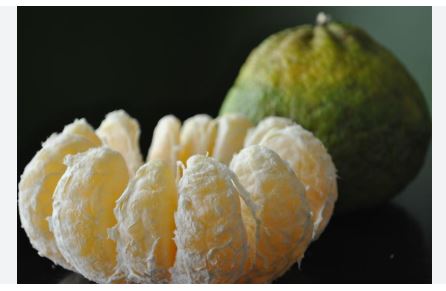
The Ugli fruit (Citrus reticulata × Citrus paradisi) is a hybrid citrus fruit that belongs to the Rutaceae family. It is a cross between a tangerine (Citrus reticulata), an orange (Citrus sinensis), and a grapefruit (Citrus paradisi). Genetically, it shares characteristics of all three, making it a distinctive member of the citrus genus (Citrus). Despite its name, the Ugli fruit is not an independent species but rather a cultivated hybrid variety known for its unusually wrinkled and bumpy rind.
The Ugli fruit originated in Jamaica in the early 20th century and is considered a naturally occurring hybrid. It was discovered growing in the wild and was later cultivated commercially for its unique flavor and ease of peeling. The name “Ugli” was trademarked by Cabel Hall Citrus Ltd., the company that began marketing the fruit. Due to its Caribbean roots, the Ugli fruit thrives in warm, tropical climates and has become a popular citrus variety in select regions across the world.
Ugli fruit is easily recognizable due to its irregular, thick, and rough-textured rind, which is often greenish-yellow to bright orange. The rind is loosely attached, making it exceptionally easy to peel by hand. The fruit varies in size, typically ranging from that of a large orange to a small grapefruit. Its flesh is juicy, segmented, and ranges from pale orange to deep yellow. Ugli fruit has a mildly sweet flavor with a hint of tartness, making it less bitter than grapefruit and more refreshing than oranges. It also contains very few seeds, making it convenient to eat fresh.
The Ugli fruit was first discovered in the early 1900s in Jamaica, growing as an accidental hybrid. Its commercial cultivation started in the 1930s, and it was introduced to the global market under the brand name “Ugli.” Despite its less-than-attractive exterior, the fruit quickly gained popularity due to its easy-to-peel skin and pleasant taste. Today, it is grown in limited quantities, primarily in Jamaica and some parts of Florida, California, and Australia, where citrus crops thrive.
Ugli fruit thrives in USDA Hardiness Zones 9-11, where temperatures remain warm year-round. It prefers subtropical and tropical climates, similar to other citrus fruits. The tree requires well-draining soil, full sunlight, and protection from frost. Although it can tolerate short periods of cooler weather, prolonged exposure to freezing temperatures can damage the fruit and reduce yields. Like other citrus trees, it benefits from regular pruning and fertilization to enhance fruit production.
Ugli fruit is a powerhouse of essential nutrients, making it an excellent addition to a healthy diet. It is rich in vitamin C, which boosts the immune system, promotes collagen production, and aids in wound healing. The fruit also provides a good amount of fiber, which supports digestive health and helps regulate blood sugar levels. Additionally, it contains antioxidants, such as flavonoids and carotenoids, which help reduce inflammation and combat oxidative stress in the body. Ugli fruit is low in calories and contains no cholesterol or fat, making it a heart-friendly food that may help manage weight and improve cardiovascular health.
The versatility of Ugli fruit makes it a fantastic ingredient in both sweet and savory dishes. It can be eaten fresh, either as a snack or in fruit salads, adding a burst of citrus flavor. Its juice can be used as a refreshing beverage, in smoothies, or as a base for citrus dressings and marinades. In savory dishes, Ugli fruit pairs well with seafood, chicken, and pork, lending a bright and slightly tangy flavor to glazes and sauces. It can also be used in desserts such as sorbets, tarts, and citrus-infused baked goods. Additionally, the zest of the fruit can enhance the aroma and taste of various recipes, much like oranges or lemons.
Ugli Fruit: Cultivation
- Climate Requirements – Ugli fruit thrives in warm, tropical, and subtropical climates, requiring temperatures between 70-85°F (21-29°C). It is best suited for USDA Hardiness Zones 9-11.
- Sunlight Needs – The tree requires full sunlight for at least 6-8 hours per day to promote healthy growth and fruit production. Partial shade can reduce yield and fruit quality.
- Soil Conditions – Well-draining, sandy, or loamy soil with a slightly acidic to neutral pH (5.5-7.0) is ideal. Poor drainage can lead to root rot.
- Propagation Methods – Ugli fruit is typically propagated through grafting or budding onto hardy citrus rootstocks, as growing from seeds may not yield true-to-type fruit.
- Planting Process – Trees should be spaced 12-15 feet apart to allow proper air circulation and growth. When planting, ensure the graft union remains above soil level.
- Watering Requirements – Young trees need regular watering (2-3 times per week), while mature trees require deep watering once a week. Overwatering can lead to fungal diseases.
- Fertilization – Use a balanced citrus fertilizer (e.g., 10-10-10 or 6-6-6), applied three times per year—early spring, mid-summer, and early fall—to encourage strong growth and fruiting.
- Pruning & Maintenance – Regular pruning helps maintain shape, remove dead or diseased branches, and improve airflow. Avoid excessive pruning, as it may reduce fruit production.
- Pollination & Flowering – Ugli fruit trees are self-pollinating, meaning they do not require another tree for fruit production. However, bees and other pollinators enhance fruit set.
- Pest & Disease Control – Common pests include aphids, citrus leaf miners, and scale insects. The tree is susceptible to citrus canker and root rot, which can be managed with proper sanitation and organic sprays.
- Harvesting – Fruits take about 8-12 months to mature after flowering. They are ready for harvest when the skin turns yellow-orange with green patches and feels slightly soft.
- Storage & Post-Harvest Handling – Ugli fruits can be stored at room temperature for up to 2 weeks or refrigerated for 3-4 weeks. Proper handling prevents bruising and extends shelf life.